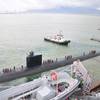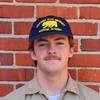On October 7 in Washington, D. C., the Association for Rescue at Sea (AFRAS), will award its Gold Medal and a cash prize to United States Coast Guardsman Roman D. Baligad, Aviation Survival Technician Second Class for a heroic rescue on 30 December, 2002. AFRAS will also present its AMVER plaque to the captain and crew of the Japanese-flagged ship M/V AUTOMOBIL ACE for exceptional humanitarian service in a rescue at sea.
The award ceremony and reception will be co-hosted by The Honorable Howard Coble, co-Chairman, U.S. Congressional Coast Guard Caucus.
The Gold Medal awardee – Roman D. Baligad - is cited for heroic achievement while serving as rescue swimmer aboard helicopter CGNR 6533 out of CG Air Facility Newport, OR. The helicopter was responding to a call at 0234 local time from the tug PRIMO BRUSCO, a 99-foot vessel with a log barge in stern tow and a crew of five, and taking on water approximately 20 miles southwest of Florence. The master of the tug reported that the crew was investigating the flooding and that they were wearing survival suits.
En route to the PRIMO BRUSCO’s reported position, Petty Officer Baligad and the other crew members encountered 40-50 knot winds, with occasional gusts to 70 knots and turbulence. In addition, a thick cloud cover and heavy rain squalls eliminated moonlight illumination and rendered night vision goggles ineffective. As a result, all members of the crew experienced some degree of flight-induced nausea and conducted much of the transit using only their flight instruments.
Arriving on scene after a 50-minute transit, Aircraft Commander LT DeCoopman directed his crew to turn off all exterior aircraft lights to enhance night vision goggle use through the heavy rain. As all communication with the tug had been lost, the Coast Guard crew was searching by an EPIRB transmission received from the vessel. The helicopter made several attempts to find the position of the barge, but had to climb to 75 feet due to 30-foot waves breaking below. Finally, LT DeCoopman saw barge lights, but could not make out the barge. As they continued forward, AST2 Baligad advised, “Crane, crane!” and copilot LT MacMillan commanded, “Hard left, hard left!” Lt DeCoopman banked the aircraft and performed an instrument climbout to 300 feet. AST2 Baligad and Flight Mechanic AVT2 Chynoweth affirmed during debriefs that the aircraft had barely missed the crane.
Back at altitude, the crew was informed via radio that at least two members of the tug’s five-man crew had been located on a life raft by another CG helicopter that was on scene. Three additional crewmen from the barge were possibly in the water. Aircraft Commander DeCoopman descended to 75 feet near the first of three strobe lights which had been located on the water. The flight mechanic started sending rescue swimmer Baligad down, and he was halfway there when the crew realized the strobe light was attached to an empty lifering. Petty Officer Baligad was brought back up while the helicopter taxied 600 feet to the next light. This light turned out to be an EPIRB. A survivor was located at the third strobe light and Baligad was deployed from CGNR 6533.
The flight mechanic worked incredibly hard to steady Petty Officer Baligad as he swayed back and forth in the 50 to 60 knot winds from the 75-foot hoist. On four occasions Baligad was hit by 30-foot waves that rolled underneath the helicopter. Each time Baligad moved close to the survivor, the winds would blow him out of reach or the heavy seas would push the survivor away. For nearly 12 minutes the helicopter hovered while the flight mechanic tried to get rescue swimmer Baligad close enough to enter the water. During this time the helicopter fuel continued to burn lower and was reaching a minimum limit for safe return to Florence (15 minutes away). Just as the aircraft commander was about to direct an abort, the flight mechanic advised him that Baligad had disconnected from the hoist cable and was swimming toward the survivor.
Recognizing the opportunity to safely enter the water on the peak of a large wave, and fully understanding that he may be left on scene with the tug crewmen, AST2 Baligad made the decision to disconnect from the hoist cable in order to reach, evaluate and rescue the survivor. The aircraft commander immediately called for a basket pickup of the survivor, knowing that if they couldn’t pick up the survivor and rescue swimmer in a few minutes, a critical fuel state would force them to depart. Despite the large waves, Baligad quickly loaded the survivor into the basket and he was hoisted aboard the aircraft. Another rapid basket delivery resulted in Baligad being returned to the helicopter. CGNR 6533 departed scene and arrived at the Florence Airport at 0529, where the survivor was transferred to awaiting Emergency Medical Services.
Petty Officer Baligad's courage, judgment and devotion to duty in the most demanding of circumstances are most heartily commended.
The Association for Rescue at Sea is also pleased to present its AMVER plaque to the captain and crew of the Japanese-flagged M/V AUTOMOBIL ACE for an extremely well executed and complex rescue in August of 2002. The AMVER Safety Network is a voluntary, worldwide ship reporting system, which is operated by the United States Coast Guard and involves ships from over 140 nations.
On 12 August 2002, USCG Group San Francisco received a report from the sailing vessel MINTAKA relaying a request for medevac of a 56-year old male in urgent need of medical attention on board the 36-foot sloop ALCYONE. Due to the location the Group passed the case on to Command Center, which in turn passed it on to AMVER, who identified, contacted and diverted the 800-foot vehicle carrier M/V AUTOMOBIL ACE, 7 hours away, to assist. At the same time, USCG Cutter STEADFAST, along with an embarked CG helicopter, steamed at best speed to meet the AMVER ship and provide transport to land.
AUTOMOBIL ACE arrived on scene and embarked the patient plus the master of the S/V, a 67-year old male who was also in need of medical attention. The ship then diverted and rendezvoused with STEADFAST approximately 400 NM off the California shore. After several hours of coordination, the command center made arrangements for the 85th Special Operations Wing from Kirtland Air Force Base, New Mexico, to conduct a para-rescue delivery to stabilize the two patients.
The four USAF Para-Jumpers (PJ’s) dropped from a C-130 aircraft alongside the merchant vessel and used an inflatable boat to transit to the ship. After the paramedics stabilized both patients, the cutter and the merchant ship accomplished a difficult evacuation of both the patients and the PJ’s, including one of the patients requiring hoist by litter. The two were then airlifted to a waiting ambulance which delivered them to the Stanford University Hospital.
AFRAS salutes the captain and crew of M/V AUTOMOBIL ACE for responding in the tradition of AMVER and for coordinating such an extensive and successful rescue. AFRAS would also like to note that during the course of this rescue, Mr. Zaw Win Lwin of Myanmar, the Bosun of M/V AUTOMOBIL ACE was killed as a result of a head injury suffered while recovering the inflatable boat. Our sincere sympathies to the family, friends and co-workers of Lwin.
Featured videos

Inside the Electrified Truckable Tug

Tracking Foreign Vessels Working in the U.S. Jones Act Market

Inmarsat Enhances Service to Drive Digitalization
Subscribe for
Maritime Reporter E-News
Maritime Reporter E-News is the maritime industry's largest circulation and most authoritative ENews Service, delivered to your Email five times per week









